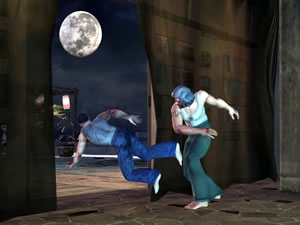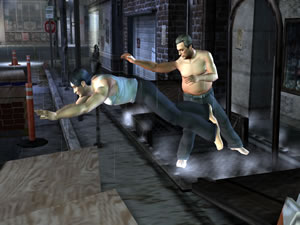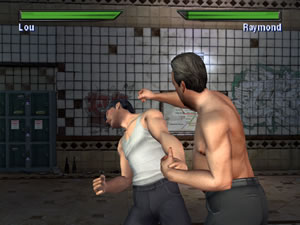The Only Rule of Fight Club: Do Not Play Fight Club.
You can tell more about a person from who’d they fight than from all their interests combined, alphabetized, and stored in an easy-to-reference box set. Who would you most like to punch if the opportunity presented itself?
Here are a few ideas: Historical Figure: Pontius Pilate. He whacked Jesus, which eventually gave Jerry Falwell a job. Pro Athlete: Kobe Bryant. Way to blow it, mini-Jordan. Entertainer: Carrot Top. No comment. Musician: David Hasselhoff. No comment, part two.
And last but not least, Video Game: Fight Club. Plenty of comments en route.
Though it came out in 1999, the film version of Chuck Palahniuk’s great novel will always be a classic with its twisting backstory, cutting-edge style, and revolutionary themes. The game, however, manages to ignore the wealth of inspiration provided by the license and breaks its face by being a gritless, witless, brainless brawler. Join me for the beat down.
Considering the source material, the game’s main Story Mode is shockingly underdeveloped. You name your character and pick between a Brawler, Grappler, or Martial Artist template. A quick CG scene will introduce you to a dark basement and your first night at Fight Club, where you must observe Rule Number 8: “If this is your first night at Fight Club, you have to fight.” That turns out to be one helluva threat.
Drawn in, you’ll fight Random Guy Number One, beat him handily, and get a short set of pre-rendered, voiced still-screens about how your character is looking for Tyler Durden. They take you to another stage, swearing all the way, so that you can do what you just did: fight, endure 15 seconds of “story” (I’m still looking for Tyler), and zoom off to another stage. Loop this six times or so and Story Mode ends, rewarding you with none other than a new unlocked fighter named…Fred Durst.
Huh? Uh, isn’t this based on a movie based on a book? Wasn’t there MUCH more to it than mindless fighting? FRED DURST? (This is the sound of Mike’s urge to kill rising”)
Your character is just a despicable moron; any inkling of honor or revolutionary cool is utterly dashed. The game eschews the layered, philosophical concepts of the book and film, instead embracing merely the look and attitude. It’s one big cowardly lion.
 You also have your basic Arcade, Survival, and Training Modes to further bomb your neurons. By the time you’ve mashed through your third fight, you’ll realize that the fighting engine is designed to offer the most repetitive experience possible. The fact that you can play as Tyler, Man Boob Bob, and Angel Face doesn’t matter at all, since every character’s move set is directly based on one of those three templates, making them all just skins. In other words, Fight Club contains a whopping three fighters. To further simplify an already ailing system, there’s a lame combo for almost every permutation of buttons and all are basically equivalent in strength and speed. This is the anatomy of a button masher, the skeleton of failure.
You also have your basic Arcade, Survival, and Training Modes to further bomb your neurons. By the time you’ve mashed through your third fight, you’ll realize that the fighting engine is designed to offer the most repetitive experience possible. The fact that you can play as Tyler, Man Boob Bob, and Angel Face doesn’t matter at all, since every character’s move set is directly based on one of those three templates, making them all just skins. In other words, Fight Club contains a whopping three fighters. To further simplify an already ailing system, there’s a lame combo for almost every permutation of buttons and all are basically equivalent in strength and speed. This is the anatomy of a button masher, the skeleton of failure.
The environments do not affect the gameplay at all, which is surprising since some stages occur in the Subway, Restaurant Bathroom, or the Parking Lot. There’s room for sending an opponent over a car’s hood or slamming him into a hand dryer, but no such luck. We are having a street fight here, gentlemen.
When a fighter’s life meter is low, an exclamation point appears under it, raising a flag to go for a throw. If successful, it triggers a stylish animation of a bone breaking and the fighter loses use of that limb. It’s a neat way to add some brutality, but the fact that the breaks always happen so late in the fight and that they are performed so easily subtract from the variability that the system should offer.
If the fighting engine wasn’t so useless, Fight Club would be more interesting in its online modes. After you beat another fighter with a custom made one, you are awarded points with which you can increase your character’s strength, endurance, speed, and technique parameters. In Hardcore Mode, you must use these same points to heal your fighter if he’s too badly hurt. If he’s beyond repair, he will be forced to retire. This is somewhat interesting since it gives you a reason to tap out in order to conserve points and develop your character more in the long run’if you choose to fight another day at all.
The best part of the game is its graphics, though that’s not saying much. The characters are detailed and battle damage accrues quite well; fighters suffer broken noses and nasty shiners when they get smashed in the face. The environments are drawn nicely and really capture the dark, dank atmosphere of the movie.
 Unfortunately, most of that is undone thanks to the low framerate and choppy animation. It makes blocking more of a blind guessing game than a matter of experience or timing. The fighters shift their weight in an unrealistic fashion from one move to the next; the amount of recovery time between a spinning roundhouse kick and a simple front kick should be much more noticeable than it is. The developers spent far too much time making sure Fight Club looked good in screenshots rather than making sure it would look good during play.
Unfortunately, most of that is undone thanks to the low framerate and choppy animation. It makes blocking more of a blind guessing game than a matter of experience or timing. The fighters shift their weight in an unrealistic fashion from one move to the next; the amount of recovery time between a spinning roundhouse kick and a simple front kick should be much more noticeable than it is. The developers spent far too much time making sure Fight Club looked good in screenshots rather than making sure it would look good during play.
Music by Korn, The Dust Brothers, and Queens of the Stone Age, some of which is taken from the flick, adds a bit to the aesthetic quality. And then, Limp Bizkit shows up to demolish what little is left of Fight Club‘s genuine feel. The sound effects deliver the sense of brutality well, and are varied enough as not to induce nausea.
The rest of the game, though, might actually make you sick. So much energy was obviously dumped into recreating the stylish look of the film that all of its complex themes are missing, and they didn’t even get the basic fighting right. There’s no reason to spend more than a few minutes on Fight Club, but a better idea is to follow the rules and not even acknowledge it at all.
-
Broken bones
-
Broken animations
-
Pathetic Story mode
-
Lame fighting engine
-
All moves based on three templates
-
Fails to capture the spirit of its license











